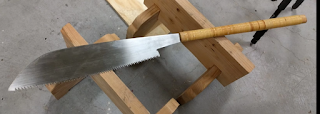On Sunday, after church my grandson and I crashed down to the shop to make another boat. Last September 6th we made a submarine.
 |
| A proud maker. |
Last weekend we made a boat that provides support services to this submarine.
This type of ship was our basic inspiration, but we did not have enough time to really do the project justice. There is nothing better that working with an enthusiastic seven year old with a plan, also almost nothing as challenging. We also added a time crunch to this project which is partially why my shop is a total mess.
I have tried to set an example of calm and focus in the shop with a routine of returning tools to their proper place as we work. On Sunday it was chaos, there were tools on benches, and machine tops and even the floor, when we were done. After seeing the kids off home, Eva and I jumped in our car and headed away for an over night holiday, leaving the mess behind. Today I was off running errands and so Tuesday after supper and still the shop is chaos. The house Elves do not put away tools, or sweep the shop.(sadly) I'll get to it tomorrow morning.
We were so rushed that I didn't even get a photograph of our effort. The plus side of this building project was it introduced Kieran to two new tools. We used a jig saw and a wood rasp for the first time together. I think I will try and create a project that uses the jig saw for his next visit. With the correct blade in place a variable speed jig saw can do lots of things, and he maybe ready to use it. (with coaching and supervision) Kieran is comfortable with the band saw and the drill press now and uses his small cordless drill driver for putting in screws, so it is time for some new tools.
I think the wood rasp was also popular, it clears material faster than sand paper, and speed is important when you are 7 1/2 years old.
 |
Big beard, long hair but no horns, to easy to break off,
just like on real Viking helmets. |
I need only a handle for the paint box and so am making a small carved Viking for my youngest grand child. On our last trip to Sweden she got the Puffin
 |
| the last minute puffin. |
The small carvings are a good size for small hands and are pretty much unbreakable. Once the Viking is painted it will be another bright thing for be dragged from place to place and finally lost in the long grass. (which is exactly why I make them).
This evening I am relaxing and stretching out my sore back, tomorrow back to work.
cheer, ianw































